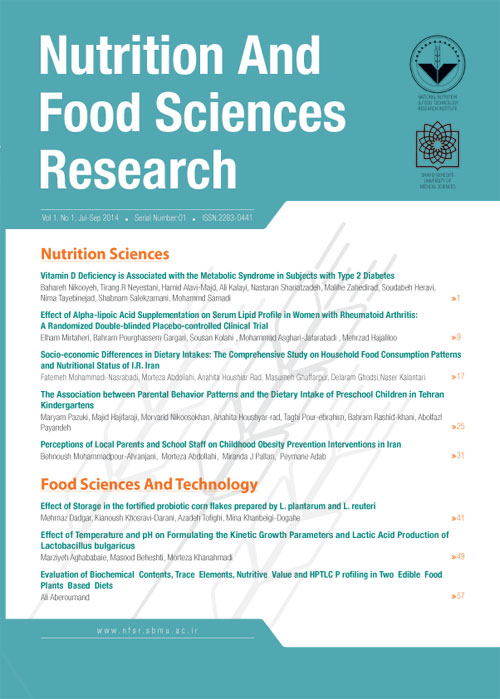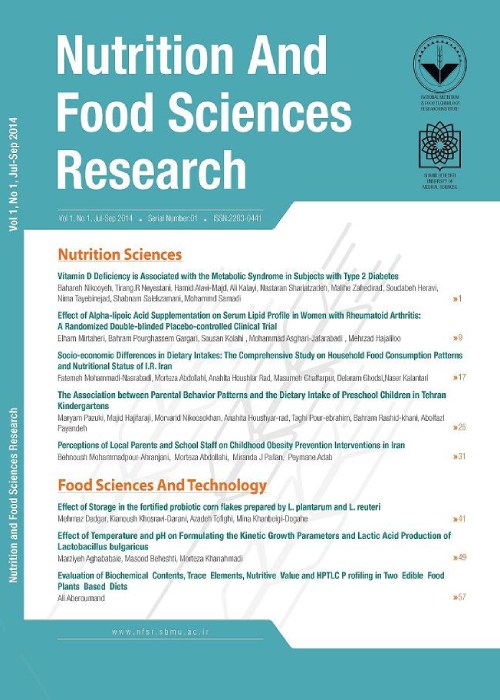فهرست مطالب

Nutrition & Food Technology Research
Volume:1 Issue: 1, Jul-Sep 2014
- تاریخ انتشار: 1393/10/04
- تعداد عناوین: 9
-
-
Pages 3-10Background And ObjectivesThere is convincing evidence that subjects concomitantly affected by type 2 diabetes (T2D) and metabolic syndrome (MeS) are at greater risk for cardiovascular disease (CVD). Many metabolic derangements in T2D might be attributed to poor vitamin D status. The purpose of this study was to investigate the associations among vitamin D status, MeS and glycemic status in subjects with T2D.Materials And MethodsA total of 101 known cases of T2D (39 males, 62 females) were enrolled in a cross-sectional study by convenient sampling. Serum 25(OH)D3, glycemic markers and lipid profile were assessed.ResultsMean concentration of serum 25(OH)D3 was 42.2±33.8 nmol/L. Prevalence of undesirable vitamin D status (25(OH)D < 50nmol/L) was significantly higher among the subjects with MeS as compared to those without MeS (p=0.020). The subjects with sufficient vitamin D status had 50% lower risk for MeS compared to those who had vitamin D deficiency, and this association remained significant even after additional adjustment for body mass index (BMI), percent of fat mass or waist circumference.ConclusionsOur data showed that firstly higher vitamin D status is inversely associated with fasting glycemia, and secondly serum 25(OH)D3 predicts MeS risk in the subjects with T2D. Demonstrating the association of hypovitaminosis D with disorders of glucose metabolism and higher risk for development of further complications, notably CVD, may lead to a new target for preventive efforts at the population level.Keywords: Vitamin D_Type 2 diabetes_Metabolic syndrome_Cardiovascular disease
-
Pages 11-18Background And ObjectivesAlpha-lipoic acid (ALA) is considered as a potent antioxidant with anti-inflammatory functions. Moreover, a number of studies have revealed its lipid lowering properties. Therefore, we aimed to examine the effect of ALA on serum lipids in women with rheumatoid arthritis (RA), who have high mortality rate mainly due to accelerated atherosclerosis.Materials And MethodsIn the present study a total of 70 RA patients were randomly assigned into two groups (1:1) to receive either ALA (1200 mg/day) or placebo for 8 weeks. Fasting blood samples were obtained before and after the intervention to analyze serum lipid profile including triglycerides (TG), total cholesterol (TC), high density lipoprotein cholesterol (HDL-C), and low density lipoprotein cholesterol (LDL-C). International physical activity questionnaire (IPAQ) was assessed at baseline and final. Between-group comparisons were done using Student’s t-test and ANCOVA at baseline and after 8 weeks, respectively. Paired t-test was used for within-group comparisons. Sign test and Mann-Whitney’s test were used for intra- and inter-group comparisons of qualitative variables, respectively. P<0.05 was considered as significant.ResultsFinally, 65 RA patients completed the trial. No statistically significant differences were observed in serum lipid levels within and between the groups before and after the study. There were no significant intra- and inter-group differences in physical activity levels at the beginning and in the end of the study.ConclusionsIn the present study, serum lipid profile was not significantly affected by ALA intervention. However, ALA supplementation aiming at prevention or treatment of dyslipidemia in RA patients should be further investigated.Keywords: Lipoic acid, Supplementation, Rheumatoid arthritis, Women, Lipid profile
-
Pages 19-26Background And ObjectivesAn association between socioeconomic status (SES) and poor health has been recognized. Inequalities in nutrition have been associated with inequalities in health. This study aimed to identify the social variability in the food and nutrient intake of Iranian households.Materials And MethodsThis study was conducted in the framework of the Comprehensive Study on Household Food Consumption Patterns and Nutritional Status of I.R. Iran during 2001-2003. Households were selected by cluster systematic sampling method in urban and rural areas. SES was assessed through in-depth interviews. Assessment of food and nutrient intake was done using three consecutive 24-hour diet recalls completed by trained nutritionists. Some of the socio-economic variables were extracted by factor analysis as indicators of SES.ResultsAmong the 7158 studied households, 2496 (34.9%) were rural and 4662 (65.1%) were urban dwellers. Consumption of the food groups, including bread and cereals, vegetables, fruits, meats, eggs, milk and dairy products, sugar and sweets, was significantly different by the level of education, occupation (P<0.001) and living conditions (P<0.05). These factors explained 70% of variance in SES. In higher quintile of SES, consumption of bread and cereals, as well as sugar and sweets significantly decreased and meats, vegetables and fruits was increased. Intake of protein, calcium, vitamin C, riboflavin and retinol was higher in the third quintile of SES as compared to the first quintile (P<0.05).ConclusionsBased on our findings, an unhealthier dietary intake may exist among the households belonging to lower socio-economic level in Iran. This calls for appropriate policy making and intervention(s).Keywords: Socio, economic status, Food, nutrient intakes, Factor analysis, Household
-
Pages 27-32Background And ObjectivesThis study was designed to investigate the association between parental behavior and the dietary intake of Tehranian preschool children aged 2-6 years.Materials And MethodsIn a cross-sectional study conducted on 310 children aged 2-6 years from the kindergartens of 22 districts of Tehran, a qualitative validated 85-item food frequency questionnaire was completed by interviewing with their parents. Also the effect of parental behavior on the children’s dietary intake was assessed using a validated comprehensive feeding practices questionnaire (CFPQ).Results47 and 53% of children were girls and boys, respectively. Among the parental behavior patterns, encouraging children to eat healthy foods, using food rewards, teaching and talking with children about the value of foods, encouraging the children to participate in food purchasing and preparation, making available the healthy foods, parental controlling behavior, child’s control, restricted behaviors because of having weight loss diet, and role modeling were significantly associated with the dietary intake of food groups (P<0.05).ConclusionsAny effort to promote children’s dietary intake needs considering the role of parents in the development of feeding patterns, and interest in children to consume healthy foods.Keywords: Children, Dietary intake, Parental behavior patterns, Kindergarten
-
Pages 33-40Background And ObjectivesChildhood obesity is an increasing public health problem in Iran, and there is no evidence for effective prevention strategies to date. The aim of this qualitative study was to identify and prioritise perceived potential interventions by parents and school staff to help inform the development of an obesity prevention intervention for Iranian school children.Materials And MethodsFocus groups were held with the parents of primary school aged children and school staff working in primary schools in Tehran city. Additionally, three interviews were held with two physical education teachers and one school nurse. The participants were asked about the causes of obesity and what activities they believed would help children to maintain healthy weight. Then they were asked to prioritise the activities that would have the greatest impact on children to maintain their healthy weight. Thematic analysis was used to analyse the data. Parents were selected from a range of socio-economic backgrounds to include two groups from each of high, medium, and low socio-economic districts of Tehran. Eleven focus groups were held with a total of 85 participants.ResultsPublic policy interventions included the provision of valid nutrition information, physical activity promotion, and accessibility to healthy foods. School-based interventions included improving physical education, providing organised physical activity, provision of good quality education for children, parents and school staff, improving school shops, and using rewards and competitions. The findings suggest that close liaison should be established between the school, the family, and the broader community.ConclusionsThis study provided important contextual data on where the emphasis should be placed in developing the childhood obesity prevention interventions for the school children in Tehran. The findings further highlight the importance of involving a wide range of stakeholders, and including multiple components to maximise the chances of success.Keywords: Child, Obesity, Prevention, Intervention, Qualitative research, Iran
-
Pages 41-48Background And ObjectivesNowadays corn flakes are the most common form of breakfast cereals; however, their vitamins are declined during the baking process. In this research, production of fortified corn flakes by Lactobacillus plantarum and L. reuteri, as well as incorporation of oat and malt fiber as prebiotics have been studied.Materials And MethodsPlackett-Burman statistical design was used to evaluate the impact of eleven-process variables on the viability of both probiotics.ResultsThe highest survival rate of L. plantarum (340 ×106 CFU.g-1) was obtained by 2.5% w/w inoculation of a 24 h inoculum in a medium containing 10% w/v oat extract to enrich corn flakes (10% w/w malt fiber), packed in aluminum foil and kept at 20 °C in anaerobic conditions for 2 weeks. Also the highest survival rate of L. reuteri (123 ×106 CFU.g-1) was achieved when the 48 h cultured bacteria grown in a medium containing 5% w/v malt extract and MRS broth was inoculated (2.5% w/w) to the flakes enriched by 20% w/w malt fiber, and kept in anaerobic conditions inside the polypropylene cover packaging at 20 °C for 2 weeks.ConclusionsSensory evaluation showed no significant difference between the treatments in terms of taste, odor and overall acceptability as compared to the control.Keywords: Corn flakes. Probiotic. Prebiotic. Plackett, Burman design
-
Pages 49-56Background And ObjectivesLactobacillus delbrueckii ssp bulgaricus is widely used in dairy industries as a starter for yogurt production. This study was designed using response surface methodology (RSM) in 12 batch pH-controlled cultures of Lactobacillus delbrueckii sub-ssp. bulgaricus for determining the effect of temperature and pH on the biomass production of a native strain of L. bulgaricus, and its main metabolite, lactic acid. The performance of Richards model for prediction of L. bulgaricus kinetic growth was verified using the data obtained from the experiments.Materials And MethodsL. bulgaricus was isolated from a plain yogurt. The medium was composed of whey and yeast extracts. RSM was used to design the experiments and quantify the effects of temperature and pH on maximum cell concentration, maximum specific growth rate, total lactic acid concentration, relative growth rate (K) and exponent parameter (d) in Richards model, and product formation parameters of Luedeking-Piret equation (a & b). Matlab software (version 7.12.0) was used to estimate the parameters of Luedeking-Piret equation and Richards model for each experiment.ResultsSecond order model for Xmax, μmax, P and K was significant but product formation parameters were almost constant. The optimum values of temperature and pH for attaining maximum biomass, maximum specific growth rate, and maximum acid production were obtained at 44 °C and 5.7, respectively.ConclusionsThe attained empirical mathematical correlations of RSM alongside the kinetic equations could be used to determine growth conditions under predefined temperature and pH in the fermentation process.Keywords: Lactobacillus bulgaricus, Richards model, Response surface methodology, Lactic acid production, Luedeking, Piret model
-
Pages 57-61Background And ObjectivesThe present study was conducted to evaluate the presence of biochemical contents and trace elements, and detect phytochemicals in the edible part extracts of Asparagus officinalis DC and Chlorophytum comosum Linn by HPTLC.Materials And MethodsThe biochemical contents and trace elements were determined by different biochemical methods, and trace elements’ presence was detected by atomic absorption spectroscopy (AAS), while phytochemicals were detected by HPTLC. Nutrients content of the leaves of Asparagus officinalis DC and Chlorophytum comosum Linn were analyzed by standard method.ResultsCrude fat and protein content of Asparagus officinalis DC and Chlorophytum comosum Linn was found to be 3.44, 2.00 and 32.69, 4.54%, respectively. Also their total carbohydrate and crude fiber content was detected as 34.67, 65.84 and 18.5, 17.24%, respectively. Analysis of the edible parts confirmed the presence of phenol steroids, and showed minimum amount of trace elements with moderate nutritive value. Total phenolic content and nutritive value were found to be greater in the stem Asparagus officinalis DC as compared to Chlorophytum comosum Linn.ConclusionsOur findings suggest that both Asparagus officinalis DC and Chlorophytum comosum Linn are endowed with antioxidant phytochemicals and nutritive values.Keywords: Asparagus officinalis DCChlorophytum comosum Linn, Nutritive values


